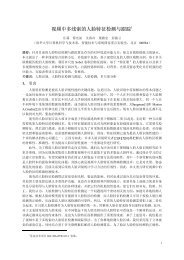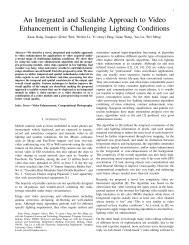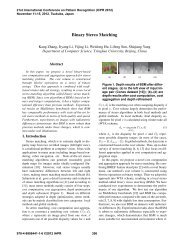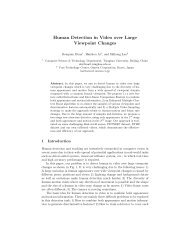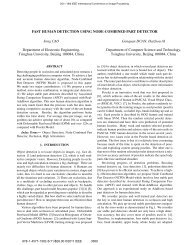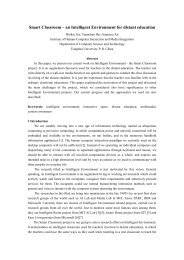An Efficient and Integrated Algorithm for Video Enhancement in ...
An Efficient and Integrated Algorithm for Video Enhancement in ...
An Efficient and Integrated Algorithm for Video Enhancement in ...
Create successful ePaper yourself
Turn your PDF publications into a flip-book with our unique Google optimized e-Paper software.
2<br />
the paper <strong>and</strong> future works <strong>in</strong> Section VI.<br />
0.25<br />
II. A NOVEL INTEGRATED ALGORITHM FOR VIDEO<br />
ENHANCEMENT<br />
The pecentage of pixels<br />
0.2<br />
0.15<br />
0.1<br />
0.05<br />
0<br />
0−31 32−63 64−95 96−127 128−159 160−191 192−223 224−255<br />
Distribution of haze videos<br />
0.25<br />
Fig. 1. Examples of orig<strong>in</strong>al (Top), <strong>in</strong>verted low light<strong>in</strong>g videos/images<br />
(Middle) <strong>and</strong> haze videos/images (Bottom).<br />
The motivation <strong>for</strong> our algorithm is a key observation that<br />
if we per<strong>for</strong>m a pixel-wise <strong>in</strong>version of low light<strong>in</strong>g videos or<br />
high dynamic range videos, the results look quite similar to<br />
hazy videos. As an illustrative example, we r<strong>and</strong>omly selected<br />
(by Google) <strong>and</strong> captured a total of 100 images <strong>and</strong> video<br />
clips <strong>in</strong> haze, low light<strong>in</strong>g <strong>and</strong> high dynamic range weather<br />
conditions respectively. Some examples are shown <strong>in</strong> Fig. 1.<br />
Here, the “<strong>in</strong>version” operation is simply<br />
R c (x) = 255 − I c (x), (1)<br />
where R c (x) <strong>and</strong> I c (x) are <strong>in</strong>tensities <strong>for</strong> the correspond<strong>in</strong>g<br />
color (RGB) channel c <strong>for</strong> pixel x <strong>in</strong> the <strong>in</strong>put <strong>and</strong> <strong>in</strong>verted<br />
frame respectively.<br />
As can be clearly seen from Fig. 1, at least visually, the<br />
video <strong>in</strong> hazy weather are similar to the <strong>in</strong>verted output<br />
of videos captured <strong>in</strong> low light<strong>in</strong>g <strong>and</strong> high dynamic range<br />
conditions. This is <strong>in</strong>tuitive because as illustrated <strong>in</strong> [7], <strong>in</strong><br />
all these cases, e.g. hazy videos <strong>and</strong> low light<strong>in</strong>g videos, light<br />
captured by the camera is blended with the airlight (ambient<br />
light reflected <strong>in</strong>to the l<strong>in</strong>e of sight by atmospheric particles).<br />
The only difference is the actual brightness of the airlight,<br />
white <strong>in</strong> the case of haze videos, black <strong>in</strong> the case of low<br />
light<strong>in</strong>g <strong>and</strong> high dynamic range videos.<br />
The observation is confirmed by various haze detection<br />
algorithms. We implemented haze detection us<strong>in</strong>g the HVS<br />
threshold range based method [8], the Dark Object Subtraction<br />
(DOS) approach [9], <strong>and</strong> the spatial frequency based technique<br />
[10], <strong>and</strong> found that hazy, <strong>in</strong>verted low light<strong>in</strong>g videos <strong>and</strong><br />
<strong>in</strong>verted high dynamic range videos were all classified as hazy<br />
video clips, as opposed to “normal” clips.<br />
We also per<strong>for</strong>med the chi-square test to exam<strong>in</strong>e the<br />
statistical similarities between hazy videos <strong>and</strong> <strong>in</strong>verted low<br />
light<strong>in</strong>g <strong>and</strong> high dynamic range videos. The chi-square test is<br />
a st<strong>and</strong>ard statistical tool widely used to determ<strong>in</strong>e if observed<br />
data are consistent with a specific hypothesis. As expla<strong>in</strong>ed <strong>in</strong><br />
[11], <strong>in</strong> chi-square tests, a p value is calculated, <strong>and</strong> usually,<br />
The pecentage of pixels<br />
The pecentage of pixels<br />
0.2<br />
0.15<br />
0.1<br />
0.05<br />
0.25<br />
0.2<br />
0.15<br />
0.1<br />
0.05<br />
0<br />
0<br />
0−31 32−63 64−95 96−127 128−159 160−191 192−223 224−255<br />
Distribution of low light<strong>in</strong>g videos<br />
0−31 32−63 64−95 96−127 128−159 160−191 192−223 224−255<br />
Distribution of high dynamic range videos<br />
Fig. 2. The histogram of the m<strong>in</strong>imum <strong>in</strong>tensity of each pixel’s three color<br />
channels of haze videos (Top), low light<strong>in</strong>g videos (Middle) <strong>and</strong> high dynamic<br />
range videos (Bottom).<br />
if p > 0.05, it is reasonable to assume that the deviation of<br />
the observed data from the expectation is due to chance alone.<br />
In our experiments, the expected distribution was calculated<br />
from hazy videos <strong>and</strong> the observed statistics from <strong>in</strong>verted low<br />
light<strong>in</strong>g <strong>and</strong> high dynamic range videos were tested. In the<br />
experiments, we divided the range [0, 255] of color channel<br />
<strong>in</strong>tensities <strong>in</strong>to eight equal <strong>in</strong>tervals, correspond<strong>in</strong>g to a degree<br />
of freedom of 7. Accord<strong>in</strong>g to the chi-square distribution<br />
table, if we adopt the common st<strong>and</strong>ard of p > 0.05, the<br />
correspond<strong>in</strong>g upper threshold <strong>for</strong> the chi-square value should<br />
be 14.07. The histogram of the m<strong>in</strong>imum <strong>in</strong>tensities of all color<br />
channels of all pixels <strong>for</strong> hazy videos, <strong>in</strong>verted low light<strong>in</strong>g<br />
<strong>and</strong> <strong>in</strong>verted high dynamic range videos were used <strong>in</strong> the tests,<br />
some examples are shown <strong>in</strong> Fig. 2. The results of the chi-



